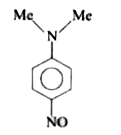Aniline on treatment with nitrous acid (NaNO2+HCl) at 0∘C froms :
phenol
nitrobenzene
nitrosobenzene
benzene diazonium chloride
To solve the question regarding the reaction of aniline with nitrous acid (NaNO₂ + HCl) at 0°C, we will follow these steps:
Step 1: Understand the Reactants
Aniline (C₆H₅NH₂) is an aromatic amine. When treated with nitrous acid, which is generated from sodium nitrite (NaNO₂) and hydrochloric acid (HCl), a diazonium salt can be formed.
Hint: Identify the structure of aniline and the components of nitrous acid.
Step 2: Formation of Nitrous Acid
In solution, sodium nitrite (NaNO₂) dissociates to give Na⁺ and NO₂⁻ ions. In the presence of HCl, nitrous acid (HNO₂) is formed:
NaNO2+HCl→HNO2+NaCl
Hint: Recognize that HNO₂ is the active species in this reaction.
Step 3: Protonation of Nitrous Acid
In an acidic medium, nitrous acid can exist in a protonated form, which is more reactive. The structure can be represented as:
HNO2→H2O+N+2
Hint: Consider how the acidic environment affects the stability and reactivity of nitrous acid.
Step 4: Reaction with Aniline
Aniline (C₆H₅NH₂) reacts with the nitrous acid. The amino group (-NH₂) of aniline is a nucleophile and attacks the positively charged nitrogen in the nitrous acid, leading to the formation of a diazonium ion:
C6H5NH2+HNO2→C6H5N+2+H2O
Hint: Identify the nucleophilic attack and the resulting product.
Step 5: Formation of Benzene Diazonium Chloride
The diazonium ion formed can then combine with the chloride ion (Cl⁻) from HCl, resulting in benzene diazonium chloride:
C6H5N+2+Cl−→C6H5N2Cl
Hint: Recognize the final product and its significance in organic chemistry.
Conclusion
The final product of the reaction of aniline with nitrous acid at 0°C is benzene diazonium chloride (C₆H₅N₂Cl), which corresponds to option 4.
Final Answer: Benzene diazonium chloride (C₆H₅N₂Cl).
Aniline (C₆H₅NH₂) is an aromatic amine. When treated with nitrous acid, which is generated from sodium nitrite (NaNO₂) and hydrochloric acid (HCl), a diazonium salt can be formed.
In solution, sodium nitrite (NaNO₂) dissociates to give Na⁺ and NO₂⁻ ions. In the presence of HCl, nitrous acid (HNO₂) is formed:
NaNO2+HCl→HNO2+NaCl
In an acidic medium, nitrous acid can exist in a protonated form, which is more reactive. The structure can be represented as:
HNO2→H2O+N+2
Aniline (C₆H₅NH₂) reacts with the nitrous acid. The amino group (-NH₂) of aniline is a nucleophile and attacks the positively charged nitrogen in the nitrous acid, leading to the formation of a diazonium ion:
C6H5NH2+HNO2→C6H5N+2+H2O
The diazonium ion formed can then combine with the chloride ion (Cl⁻) from HCl, resulting in benzene diazonium chloride:
C6H5N+2+Cl−→C6H5N2Cl
The final product of the reaction of aniline with nitrous acid at 0°C is benzene diazonium chloride (C₆H₅N₂Cl), which corresponds to option 4.
Topper's Solved these Questions
Similar Questions
Knowledge Check
Which amine yields N-nitroso amine after treatment with nitrous acid (NaNO2,HCl) ?
A B
B C
C D
D
N,N-dimethyl aniline react with NaNO2 and dilute HCl at 0−5∘C to form :
A B
B C
C D
D
Which of the following compounds will form a yellow -coloured oily compound on treatment with NaNO2 and HCl at 0−5∘C ?
A B
B C
C D
D
0.2 g of a primary aliphatic amine, on treatment with nitrous acid gave 61.36 ml of N2 gas at STP. The molecular mass of the amine will be:
View SolutionStatement I: Aniline on reaction with NaNO2HCl at 0∘C followed by coupling with β-naphthol gives a dark blue coloured precipitate.
Statement II: The colour of the compound formed in the reaction of aniline with NaNO2/HCl at 0∘C followed by coupling with β-naphthol is due to extended conjugation.
View Solutiono-Chloroaniline is treated with a mixture of NaNO2 and HCl and the product is reacted with cuprous bromide. The final product in the reaction will be
View SolutionAniline is treated with a mixture of NaNO2 and excess of HCl at low temperature.
View SolutionAniline react with NaNO2 and dil. HCl at 0−5∘C to form :
View Solution
